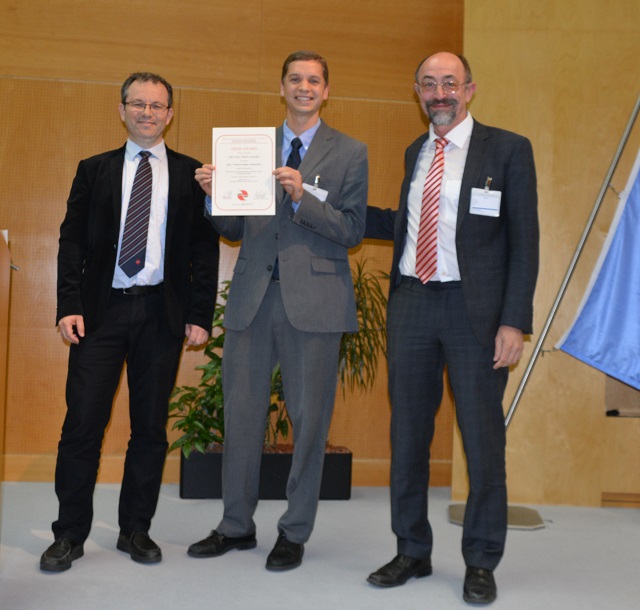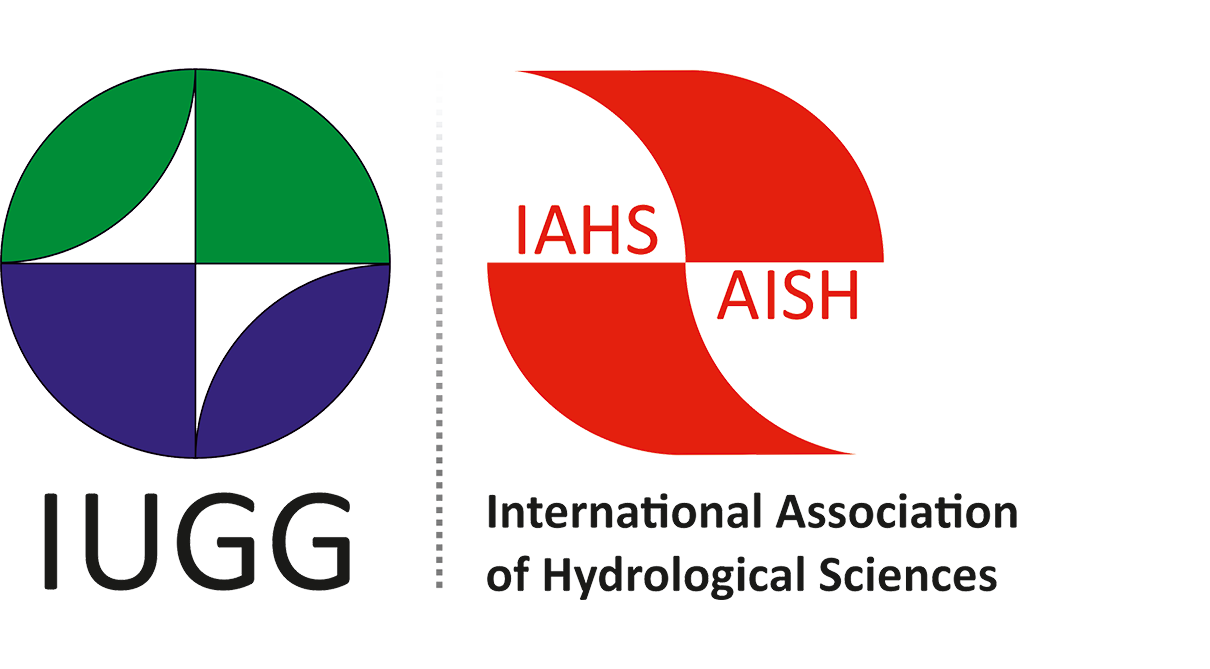The 2018 Tison Award goes to Ryan T. Bailey & Saman Tavakoli Kivi

Left to right: Christophe Cudennec (Secretary General IAHS), Ryan T. Bailey (Colorado State University, Tison Award Recipient), Günter Blöschl (President IAHS). Photos courtesy of WMO.
The winning paper is:
Ryan T. Bailey & Saman Tavakoli Kivi (2017) Method for estimating available groundwater volume of small coral islands, Hydrological Sciences Journal, 62:14, 2381-2392, DOI:10.1080/02626667.2017.1382703
Citation from Christophe Cudennec Secretary General IAHS on behalf of the Jury of the 2018 Tison Award
The Tison Award for 2018 goes to two authors – Ryan Bailey and Saman Tavakoli Kivi, both from the Department of Civil and Environmental Engineering, Colorado State University, Fort Collins, Colorado, USA. The award is for their paper “Method for estimating available groundwater volume of small coral islands”, published in Hydrological Sciences Journal in 2017.
In their paper, the authors have developed a clever new approach for estimating groundwater volume on coral islands. From a practical point of view, this paper is a significant step forward, since little previous relevant science was available. The approach has practical value in the planning and management of water resources. This paper can help a community of users, especially in developing nations, that are otherwise neglected by the mainstream research in our discipline.
The judges liked the paper because it addresses a problem of high societal relevance with new ideas building upon older methods. They especially appreciate that the authors developed a practically applicable approach, which they evaluated for real world sites, including typical uncertainties likely to affect the application of the method. The paper was clearly presented, thorough, and enjoyable to read.
Although there was strong competition from the other 11 nominated papers, this paper was a clear winner with strong support from several jury members.
Among other values, the 96 year old IAHS strongly acknowledges and supports the universality of Science of the international scientific cooperation. The records of the Tison award show examples of co-authorships which materialize those values, especially France-Tunisia, Zimbabwe-Colombia-The Netherlands and Iceland-France. I am happy to note that 2018 provides another example with co-authors with USA and Iranian citizenships, actually cooperating in the USA, dealing with coral islands of the Pacific Ocean.
In closing, Ross Woods, chair of the 2018 jury, and I congratulate the authors and wish them further scientific successes hoping that the Tison Award received from the International Association of Hydrological Sciences will help them achieve new heights in their careers.
Christophe Cudennec Secretary General IAHS
WMO, Geneva, 8 May 2018
Response from Ryan Bailey
Dear Professor Cudennec,
My co-author Saman Tavakoli and I wish to thank you and all the members of the Tison Award committee for this award. We feel it is a great honor, and are truly humbled and grateful.
People often ask me why researchers in Colorado, USA are performing work on small tropical islands in the Pacific Ocean. Well, the work presented in our paper began during my thesis work at the University of Guam 11 years ago, when my task was two-fold: first, use complex models to assess groundwater supply on small coral islands under droughts conditions and wave overwash events; and second, to develop a simple equation that could be applied in a spreadsheet, that would allow local island water managers to determine a first-order estimate of groundwater availability for their island given factors such as island width and annual rainfall rate.
During my time as a PhD student and then as an assistant professor, I have been able to continue research and training in atoll island hydrology. The work was expanded through a small contract with the World Bank for the Republic of Maldives to analyse island groundwater supply under climate change, with the simple groundwater equation extended to estimating the volume of groundwater for an entire coral island. We are pleased to report that results from this simple method compare very well to measured field estimates of groundwater volume, which is one of the conclusions of the paper.
All along, we have attempted to provide simple yet accurate estimation tools to local water resource managers, and then provide training on the use of these tools. In this way, we have attempted to connect data, to products, and finally to services, which is the emphasis of this wonderful conference. Most of my research now deals with coupled groundwater-surface water hydrologic models for large river basins. However, as a hydrologic engineer, I hope that this paper will inspire other young hydrologists to keep hydrological solutions as simple as possible as we strive to serve humanity with a clean water supply.
Of course this work would not be possible without the initial support and guidance of my Master’s thesis advisor on Guam, Professor John Jenson, and funding agencies along the way, including the United States Geological Survey, the World Bank, and the Secretariat of the Pacific Community Global Climate Change Alliance. I would also like to thank the local chiefs and residents of Ulithi and Pingelap atolls in the Federated States of Micronesia, who allowed me an initial glimpse of water resources on atoll islands during my Master’s degree.
Foremost, I wish to thank God, my wife, and my children for their support during my ongoing training as a hydrologist.
Thank you again!
Dr Ryan T. Bailey, Tison Award Recipient
WMO Geneva, 8 May 2018
